(page 18)
December 8, 2004
Poke her with the soft cushions!
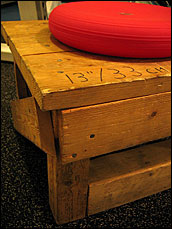 The school received a few Dynair air cushions from TOGU. These can be used for anything from sitting on (great for bad backs) to standing on for balance training. Being SQ/DL day and all, I couldn’t resist the urge to borrow one for box squats. I seem to recall reading about this precise setup somewhere, but some brief surfing turned up squat (punny yes).
The school received a few Dynair air cushions from TOGU. These can be used for anything from sitting on (great for bad backs) to standing on for balance training. Being SQ/DL day and all, I couldn’t resist the urge to borrow one for box squats. I seem to recall reading about this precise setup somewhere, but some brief surfing turned up squat (punny yes).
The idea of squatting off a soft box is not breaking news. On the Squatting Secrets tape, Simmons says that he began using a soft box back in the 1970s. These soft boxes, or hassocks, are nothing more than cheap foot rests that can be found at furniture stores (like these expensive ones, some have found theirs for less than $10 in the States). With a solid bottom and cushy top, squatting off them will make the lifter sink in a couple of inches. Needless to say, this makes the lift a lot harder and hits the legs more than an ordinary hard box. Hassock squats resemble free squats closely and are thus, or were at least, used the last 3-4 weeks prior to a meet at Westside.
Slapped the Dynair on top of my 13″ box and began pyramiding up. The cushion was indeed fairly unstable, but nothing compared to a stability ball… Tried to concentrate on form, especially arching the upper back and pulling shoulder blades tightly together while keeping elbows in. This made for added shoulder strain, but resulted in perhaps a bit less forward dipping (some older footage to compare with). Did around 10 sets at 60 kg/133 lbs then pyramided up. On the 90 kg/199 lbs single, I setup a tad too close with the result that I hit the outer edge of the cushion tilting it backwards. In the process the plates on the left side also slid out several inches. I felt some strain on the inside of the left leg from the unbalanced load and it was a really slow rep but up it came. Moved the box a bit further back for 100 kg/221 lbs, but got into a really sorry position and couldn’t even get lift off. Accessory work in circuit fashion was the coup de grâce.
This was the first semi-serious ME DL/SQ session in many months and no complaints from the back. I plan to reintroduce DE SQ/DL workouts to regain some speed and allow for further technique refinement. I’m momentarily quite content with my bench form, so expect more than a passing note on squat technique in the weeks to come. Meanwhile, feel free to lash harsh critique on today’s action (VIDEO 1M) powered by Slipknot’s Vol.3: The Subliminal Verses.
Soft cushion box squat, 13″:
Worked up to several sets @ 60 kg/133 lbs
1 @ 70 kg/155 lbs
1 @ 80 kg/177 lbs
1 @ 90 kg/199 lbs
0 @ 100 kg/221 lbs
3 circuits:
Pull-through, straight-legged: 15 @ 70 kg/155 lbs
Cable side bend: 10 @ 70 kg/155 lbs
Incline sit-up: (12,11,6)
Shrug: 10 @ 100 kg/221 lbs
Rolling Thunder: (3,2,1) @ 40 kg/88 lbs
Fastest circuit lap time: 3:40 on third iteration
Total training time: 67 min
Lift n’learn
Training blogs seem to be sprouting left and right. Following in Marie’s footsteps, I browsed in at John McDonald’s Lift n’learn started November 30th. He describes himself as a “drug-free, genetically average newbie powerlifter”, who “has not yet competed” and has been focusing on powerlifting since March 2004. He is also a stout defender of unspiced sushi lifting going at it 100% raw and drug-free. Sounds like another blog to frequent… I need to start using those RSS feeds when available pretty soon or I’ll find myself swapping all over the net looking for updates… Not that I am complaining.
Speaking of journals, Mike moved his to the Joe Average board after starting to train with Joe Parrish at Nazareth Barbell. That should make him even stronger… FAST! Note that access to it requires registration.
December 6, 2004
Making the rounds
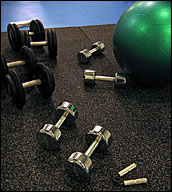 Finnish Independence Day. No work. To give the central nervous system and the shoulders further respite, I went for an upper body circuit routine with fairly light weights, one major movement per muscle group and a focus on stability ball exercises. I moved quickly between exercises only stopping to jot down the results until one iteration was completed, then took five minutes of rest before going at it again. I was huffing and puffing and kept reminding myself of the need to raise GPP, cause I ain’t got any. 23 minutes later it looked like the 5th Annual Dumbell Congregation had just convened in front of the stability ball. On our way home we ended up sitting in a traffic jam as the police had just blocked off one of the main arteries to make room for the dignitaries on their way to the President’s Independence Day Reception. System flooded with healing blood, can wait.
Finnish Independence Day. No work. To give the central nervous system and the shoulders further respite, I went for an upper body circuit routine with fairly light weights, one major movement per muscle group and a focus on stability ball exercises. I moved quickly between exercises only stopping to jot down the results until one iteration was completed, then took five minutes of rest before going at it again. I was huffing and puffing and kept reminding myself of the need to raise GPP, cause I ain’t got any. 23 minutes later it looked like the 5th Annual Dumbell Congregation had just convened in front of the stability ball. On our way home we ended up sitting in a traffic jam as the police had just blocked off one of the main arteries to make room for the dignitaries on their way to the President’s Independence Day Reception. System flooded with healing blood, can wait.
3 circuits of:
Stability ball dumbell bench: 12 @ 21 kg/46 lbs
Wide-grip pulldown, facing away from machine: 10 @ 60 kg/133 lbs
Side raise kneeling on stability ball: 8 @ 10 kg/22 lbs
Dumbell power clean sitting on stability ball: 12 @ 8 kg/18 lbs
Pressdown (lat pulley): 15 @ 25 kg/55 lbs
Dumbell curl seated on stability ball: 6 @ 16 kg/35 lbs
Captains of Crush: 10 @ Trainer
Lap times: 1st 4:40, 2nd 4:10, 3rd 4:10
Rest between circuits: 5 minutes sharp
Total training time: 23 min
An isokinetic experience
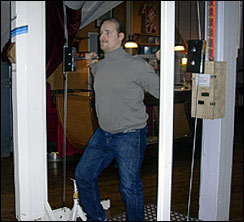
Tom Tits Experiment science centre is famous not only for its vast array of experiments from the fields of physics and chemistry, but also for its pedagogical approach of letting children learn by literary diving into the experiments on display. This was the main reason why a group of teachers, yours truly included, made the journey to the centre situated just outside of Stockholm, Sweden. That being said, powerlifters will also find something of interest here besides lessons in leverage and friendly toilet facilities. That something is the IsoKai isokinetic machine standing in the human body exhibition (take a left after the brains).
Developed in the 1990s by Swede Kai Lindberg, the IsoKai features a wire suspended barbell connected to a hydraulic system that ensures that the barbell always travels at the same speed regardless of how hard it is moved - basically, the machine generates resistance that corresponds precisely with the amount of force applied to keep speed constant. The bar can easily be lifted with two fingers, but press with all your might and you will find yourself lifting as much as you can handle.
This kind of isokinetic resistance theoretically allows the lifter to maximally activate the muscles throughout the range of motion at a particular speed - on a deadlift you might find yourself with 150 kg of resistance off the floor and 200 kg at lockout. Naturally, a conventional barbell will force the muscles to work maximally only at the sticking point.
The history of isokinetic machines goes back to 1967 when the Cybex I dynamometer (pdf file) was launched in the USA, but it was in the mid 1980s that they became popular when they were hooked up to computers for real-time feedback. Incidentally, the birth of the isokinetic machines coincides with Arthur Jones’s attempt to match resistance with maximum force capacity with his shell-shaped Nautilus cam. If it is true that both isokinetic and Nautilus machines do a pretty good job at forcing the muscle to work maximally, why are we still hooked on barbells?
Well, it boils down to three main things (at least):
- they are not functional, since there are few activities where we encounter this kind of resistance - for example, to hoist a heavy barbell we need to overcome gravity and learn to build enough speed to overcome the sticking point.
- they don’t require as much stabilizing as a free weights, thus less muscle mass is triggered - this is why squatting in a Smith machine or IsoKai will never produce the same results as going at it with a barbell.
- they (especially the isokinetic machines) don’t provide enough resistance when lowering the bar (eccentric muscle action) to promote optimum strength development.
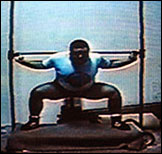 This is not to say that they don’t have their place in powerlifting. On the Westside Barbell Squatting Secrets tape (1993), Simmons credits Fred “Dr. Squat” Hatfield with introducing him to isokinetic training and goes on to explain how the machine is used at Westside with Mark Borda demonstrating (left). The short of it is that a couple of months out of the contest the force meter is set at a slow speed, but as the contest draws nearer the speed is increased while the lifter attempts to keep the force constant - if a lifter can go from reaching 1000 lbs over three seconds to producing the same force in two seconds he has clearly become faster. Not sure if this machine is still used at Westside Barbell Club, but I for one would not object to find one at my gym; the IsoKai price tag of 69,000 SEK/8,000 euros, excluding the PC, makes sure I won’t (the price is likely higher now since the quote is from 1999).
This is not to say that they don’t have their place in powerlifting. On the Westside Barbell Squatting Secrets tape (1993), Simmons credits Fred “Dr. Squat” Hatfield with introducing him to isokinetic training and goes on to explain how the machine is used at Westside with Mark Borda demonstrating (left). The short of it is that a couple of months out of the contest the force meter is set at a slow speed, but as the contest draws nearer the speed is increased while the lifter attempts to keep the force constant - if a lifter can go from reaching 1000 lbs over three seconds to producing the same force in two seconds he has clearly become faster. Not sure if this machine is still used at Westside Barbell Club, but I for one would not object to find one at my gym; the IsoKai price tag of 69,000 SEK/8,000 euros, excluding the PC, makes sure I won’t (the price is likely higher now since the quote is from 1999).
As far as isokinetic machines go, the IsoKai is cool because it gives resistance in both directions - I could first military press a mean resistance of 65 kg/144 lbs followed by a standing pulldown of 80 kg/177 lbs. Of course, the bar could also be lowered more easily when not pulling down on it like a rabid grizzly. FWIW, got a mean force of 135 kg/298 lbs on the deadlift.
The IsoKai is currently widely used to test candidates for the Swedish police and armed forces, which usually means having to pull the bar from below the knees up to the upper chest (this movement shown at Tom Tits). According to this pdf article in Swedish, the IsoKai has replaced three muscle tests previously used in the military (it also claims IsoKai is great for diagnosing whiplash injuries by looking at the force curve plotted by the computer).
Anyone got any experience with isokinetic machines?
December 5, 2004
The lift was a splashing success
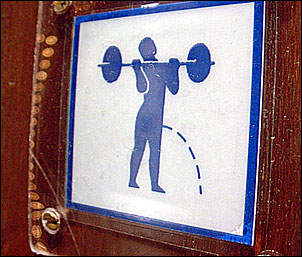
“Allt ska man se innan ögonen trillar av”, my beloved grandfather used to say. “Oh, the things my eyes have to see before they roll off” indeed comes to mind before this toilet sign. (Tom Tits Experiment science centre, Södertälje, Sweden).
December 2, 2004
December 2004 Reader Survey
 Although I have come to know some of my readers through e-mail and comments, blogging still largely feels like writing small notes that are then sucked into the great unknown. After one-and-a-half years of writing for Under the Bar and just six posts short of 300, I now think it’s high time I torture you, Dear Reader, with a survey.
Although I have come to know some of my readers through e-mail and comments, blogging still largely feels like writing small notes that are then sucked into the great unknown. After one-and-a-half years of writing for Under the Bar and just six posts short of 300, I now think it’s high time I torture you, Dear Reader, with a survey.
More than just a pseudo-scientific attempt at satisfying my own egocentric curiosity, this survey is also an excellent opportunity for you to tell me what could be done better and what should definitively not be abandoned with a few simple mouse clicks.
To show my appreciation, there is of course a lottery involved and you get to choose what you would like to win: A Captains of Crush gripper, a pair of minibands from Jumpstretch, the book The Training of the Weightlifter by Roman or a Westside T-shirt - all brand new of course. I would like to emphasize that the winner will be completely randomly drawn with no regard for how (s)he filled out the survey. So go on and fill it out honestly (no double entries permitted). The survey will be closed on December 12 at 21:00 EET (GMT +2) with results and the lottery winner announced within 10 days after that. If there are more than 30 respondents (fat chance, right?) I pledge to draw two winners.
December 1, 2004
A bit over the top
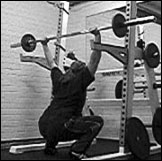 I’m going to swallow my pride and admit that I got no more than 4 @ 62.5 kg/138 lbs on the deep front squats before crashing into the pins. It wasn’t pretty either as my upper body dipped forward quite a bit. Then moved into the good mornings off the pins, now starting them, as Vince suggested, straight off the pins instead of first unracking. Worked up to 5 @ 80 kg/177 lbs, which was still fairly light. Next up were…
I’m going to swallow my pride and admit that I got no more than 4 @ 62.5 kg/138 lbs on the deep front squats before crashing into the pins. It wasn’t pretty either as my upper body dipped forward quite a bit. Then moved into the good mornings off the pins, now starting them, as Vince suggested, straight off the pins instead of first unracking. Worked up to 5 @ 80 kg/177 lbs, which was still fairly light. Next up were…
OVERHEAD SQUATS! Never tried them before, but an article in the December 2004 issue of MILO by Rob Haan titled An Alternate King: Overhead Squats put them on my agenda. Much like the hands-free squats, they smelled like a worthy challenge with some core benefits:
Mike Stone also said that very few athletes can even hold a light bar or stick directly overhead and squat, which I have found to be true. The reason is that as you squat, the torso leans forward, and because the arms must remain straight overhead to prevent the bar from falling forward, the shoulders are placed at an extreme stretch. Thus, the overhead squat is testing hip, lower back, and shoulder flexibility all at the same time, and if you are lacking in any area, the bar will end up on the floor. [..] An additional benefit - and my primary motivation for including overhead squats in a training program is that they are a great builder of core strength. [..] Overhead squats work the abdominals in the same way they are worked when you are supporting or carrying a heavy weight.
Rob Haan: An Alternate King: Overhead Squats. MILO 12(3), December 2004: pp. 56.
I also got some valuable hints from Skinny Bastard:
Always “pull the bar apart”–helps with stability.
Point the elbows out to the sides.
It’s OK to the let the bar go behind your head somewhat. For less flexible lifters, it’s usually required.
The limiting factor in terms of flexibility is usually the hamstrings and shoulders.
Start with a broomstick. Don’t expect to get depth. Just “find your balance” and go as low as possible without rounding your back. Move onto the bar and then use weight.
After all the dire warnings about impossible broomsticks and barbell-shaped heavy falling objects, working up to a successful deep set with miniscule plates felt like a major victory (TODAY’S VIDEO 3.4M). It did stretch my shoulders to the limit and I would not have dared going heavier for this very reason. I could also feel it in my upper back, which was forced into a limit arch. Torture tends to bring back memories and what I got was flashbacks of reading about Wendler’s suggestion for arching the upper back, which “not only set the entire back into a perfect squatting position, but you also force the chest out“… all essential things to staying upright in a squat. Since the overhead squat, unlike the front squat, forces you into an erect squatting groove it would seem that it is a good teacher. Alas, it is soon time to see if Mikesell would still be willing to help me work on my form.
Front squats, deep with medium stance:
5 @ 40 kg/88 lbs
5 @ 50 kg/111 lbs
5 @ 62.5 kg/138 lbs
Good mornings, off pins set at navel height:
5 @ 40 kg/88 lbs
5 @ 50 kg/111 lbs
5 @ 60 kg/133 lbs
5 @ 70 kg/155 lbs
5 @ 80 kg/177 lbs
Overhead squat, deep: worked up to 5 @ 30 kg/66 lbs
Upper body cable turn:
20 @ 40 kg/88 lbs
20 @ 50 kg/111 lbs
Standing cable crunch:
8 @ 30 kg/66 lbs
8 @ 40 kg/88 lbs
2 @ 50 kg/111 lbs
Total training time: Under 60 min
November 30, 2004
Front Squat Hands-free style
Back squatting without hands has become a concept in some powerlifting circles in Finland. Here’s a clip of zuuhis79 from the Finnish Westsidebar.net forum doing a 150 kg/332 lbs front squat hands free. Anyone?
November 29, 2004
Dead Bull
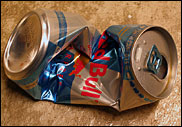 This workout can best be described as a sad déjà vu experience. I knew I wasn’t fully recovered long before I benched what turned out to be an unusually sticky 95 kg/210 lbs. Threw in the towel after failing to put a serious dent in the 85 kg/188 lbs work sets.
This workout can best be described as a sad déjà vu experience. I knew I wasn’t fully recovered long before I benched what turned out to be an unusually sticky 95 kg/210 lbs. Threw in the towel after failing to put a serious dent in the 85 kg/188 lbs work sets.
Obviously, I need to back off before I get seriously overtrained. This is definitively a suitable week to do just that as I am going to Sweden on Thursday for an extended weekend. But despair not fellow lifters, for I ain’t giving up on Wednesday’s good mornings (to be taped).
Bench pattern warm-up (the usual)
Heavy bench singles, paused: 1 @ 95 kg/210 lbs
Bench, paused: 4,4 @ 85 kg/188 lbs
Rolling Thunder: 5,5,3 @ 40 kg/88 lbs (slightly less with left)
2″ wooden block pinch grip: 5,4,5 @ 17.5 kg/39 lbs
Some Captains of Crush work
Total training time: fast as lightning
November 26, 2004
Pinocchio Fear Complex (PFC)
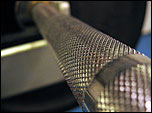 The heavy increase in pressing - up from two pressing movements and one extension movement to four pressing movements per week - has taken a hard toll on delts, triceps and chest. For the first time in two weeks I felt fairly good, but despite rubbing the taut bands in the front delts hard with both the Thumbsaver and an anti-inflammatory gel some tightness remained. It feels like I am slowly adapting to the new routine (lots of sleep helps), but might still give the decline bench the boot to lessen shoulder strain; Mike also suggested moving back to the normal Blakley split if I don’t recuperate well. Am also moving the heavy singles back to the bench on Monday from the reverse-grip bench on Friday as I feel it will help my work sets feel better.
The heavy increase in pressing - up from two pressing movements and one extension movement to four pressing movements per week - has taken a hard toll on delts, triceps and chest. For the first time in two weeks I felt fairly good, but despite rubbing the taut bands in the front delts hard with both the Thumbsaver and an anti-inflammatory gel some tightness remained. It feels like I am slowly adapting to the new routine (lots of sleep helps), but might still give the decline bench the boot to lessen shoulder strain; Mike also suggested moving back to the normal Blakley split if I don’t recuperate well. Am also moving the heavy singles back to the bench on Monday from the reverse-grip bench on Friday as I feel it will help my work sets feel better.
Pretty good workout today, but had some problems keeping my respectably sized nose clear of harm’s way as I hit it twice on the seated overhead press. On the Westside Bench Workout tape, this exercise is done against a padded board that allows the lifter to lean the upper body slightly back to clear beaks and other valuables. The back rest of the nearly vertically inclined bench I use effectively prevents even the slightest lean and as a result I am forced to press more (safe style) or less (mangled nose style) forward at the beginning to clear the head before hovering into a more optimal bar path. Next time I’ll put a board or something against the rack, for I’m sure as penguins not going to press with head turned sideways.
Reverse-grip bench: 6,6,6,6 @ 77.5 kg/171 lbs
Seated pin press, medium grip: 4,5,5,3 @ 62.5 kg/138 lbs
Reverse-grip pulldown, upper chest: 10,10,9,8 @ 80 kg/177 lbs
One-handed cable power clean: 12 @ 15 kg/33 lbs
Shrug: 3x7 @ 90 kg/199 lbs
Rolling Thunder: 5,4,5 @ 40 kg/88 lbs (about one rep less with left)
2″ wooden block pinch grip: 3x5 @ 16.25 kg/36 lbs
Captains of Crush: 3 @ I (grip fried, so…)
Total training time: 95 min (spent 10 min on a pulldown experiment that failed)